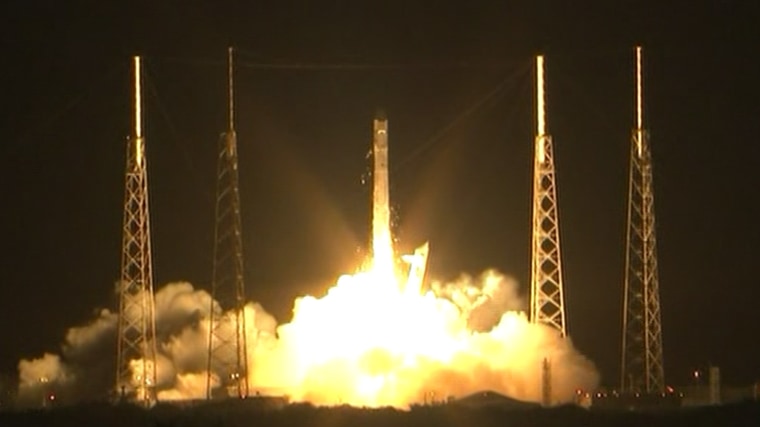SpaceX's commercial cargo ship rocketed into orbit Sunday in pursuit of the International Space Station, the first of a dozen routine supply runs under a $1.6 billion contract with NASA.
It was the second liftoff of a Dragon capsule to the orbiting lab staged by California-based SpaceX. The first launch was for a test flight in May, which carried a token amount of non-essential supplies.
This flight, in contrast, is no test: The spacecraft is carrying 882 pounds (400 kilograms) of key science experiments and other precious gear. The cargo also includes a personal touch: Cups of Blue Bell chocolate-vanilla swirl ice cream have been tucked in a freezer for the three station residents.
The company's unmanned Falcon 9 rocket roared into the night sky from Cape Canaveral Air Force Station in Florida right on time at 8:35 p.m. ET, putting SpaceX on track to reach the space station Wednesday. The complex was soaring southwest of Tasmania when the Falcon took flight.
Officials declared the launch a success — even though one of the rocket's nine first-stage engines was lost during the ascent to orbit, due to an unspecified anomaly.
SpaceX President Gwynne Shotwell said the Falcon 9's other engines compensated for the shutdown and put the Dragon capsule precisely where it was intended to go. "Falcon 9 was designed to lose engines and still make missions, so it did what it was supposed to do," Shotwell said. "We will learn from our flights and continue to improve the vehicle."
Later Sunday, SpaceX's billionaire founder, Elon Musk, said the engine failure had "no effect" on the mission.
In more good news, a piece of space junk was no longer threatening the station, and NASA could focus entirely on the delivery mission.
NASA is counting on private business to restock the space station, now that the shuttles have retired to museums. The space agency's $1.6 billion contract with SpaceX covers 12 resupply missions through 2015.
Especially exciting for NASA is the fact that the Dragon will return twice as much cargo as it took up, including a stockpile of astronauts' blood and urine samples. The samples — nearly 500 of them — have been stashed in freezers since Atlantis made the last shuttle flight in July 2011.
Due for three weeks in space
The Dragon will spend close to three weeks at the space station before being released and parachuting into the Pacific at the end of October. By then, the space station should be back up to a full crew of six.
None of the Russian, European or Japanese cargo ships can bring anything back; they're destroyed during re-entry. The Russian Soyuz crew capsules have limited room for anything besides people.
Space Exploration Technologies Corp., or SpaceX, is working to convert its unmanned Dragon capsules into vessels that could carry astronauts to the space station in three years. Other U.S. companies also are vying to carry crews. Americans must ride Russian rockets to orbit in the meantime, for a steep price.
Musk, who monitored the launch from SpaceX Mission Control in Hawthorne, Calif., called the capsules Dragon after the magical Puff to get back at critics who, a decade ago, considered his effort a fantasy. The name Falcon comes from the Millennium Falcon starship of "Star Wars" fame.
Thousands watch launch
An estimated 2,400 guests jammed the Florida launch center to see the Falcon, with its Dragon, come to life for SpaceX's first official, operational supply mission. Across the country at SpaceX headquarters, about 1,000 employees watched via TV and webcast.
NASA Administrator Charles Bolden watched the launch from Florida. "Just over one year after the retirement of the space shuttle, we have returned space station cargo resupply missions to U.S. soil and are bringing the jobs associated with this work back to America," he said in a statement. "The SpaceX launch tonight marks the official start of commercial resupply missions by American companies operating out of U.S. spaceports like the one right here in Florida."
Every time SpaceX or a competitor flies successfully, Bolden told reporters, "that gives the nonbelievers one more opportunity to get on board and root for us" and help enable commercial launches for space station astronauts. This will further free NASA up to aim for points beyond low-Earth orbit, like Mars.
"This was a big night," Bolden said.
SpaceX's next supply run is due in January. Another company looking to haul space station cargo, Virginia-based Orbital Sciences Corp., hopes to launch a solo test flight in December and a demo mission to the station early next year. If NASA gives Orbital the go-ahead after its tests, the company would be in line for as much as $1.9 billion for eight resupply flights.
SpaceX is among several companies also working on spaceships capable of flying astronauts to and from the space station, starting in the 2015-2017 time frame. SpaceX plans to offer an upgraded version of the Dragon capsule. The other companies receiving NASA funding for developing human-capable spacecraft are the Boeing Co. and Sierra Nevada Corp.
More about commercial spaceflight:
- SpaceX flight gets its own mission patch
- Why SpaceX is setting the pace in space race
- Florida wants NASA land for commercial ventures
This report includes information from The Associated Press and NBC News.
